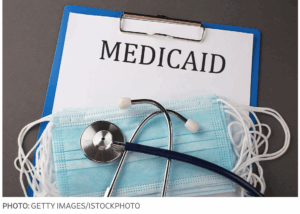
Medicaid is under the spotlight now as Congress considers legislation to lower the cost of this entitlement program. I’ve written a lot about Medicaid recently, so if you’re a regular follower of this blog you’re familiar with the problem. The problem is out of control Medicaid spending.
My television is regularly showing advertisements calling on people to tell Congress not to cut Medicaid. President Trump and House Speaker Mike Johnson have repeatedly said they have no plans to cut Medicaid benefits to anyone who is eligible. They only intend to curb the excessive waste, fraud, and abuse that has driven the cost of Medicaid beyond Defense spending to $894 Billion a year in 2024.The following graphic shows how Medicaid spending has skyrocketed in the last 10 years:

How much waste, fraud, and abuse happens in Medicaid?
Lawrence Wilson, writing in The Epoch Times, tells us The Government Accountability Office has estimated that the federal government may lose between $233 billion and $521 billion annually to fraud. Based on data provided by that office, it appears that less than 3 percent of the estimated total of fraudulent payments are proven by a judicial verdict. Much of it appears to go undetected.
Yet fraud does exist in the Medicaid system. One state lost an estimated $2 billion to Medicaid fraud over the past five years, a staff member in that state’s attorney general’s office told The Epoch Times. The Department of Health and Human Services reported that more than $31 billion in Medicaid payments were made improperly in 2024 alone.
Of those, nearly $5 billion was paid for medical services for patients who were not eligible for Medicaid, and more than $10 billion was paid for claims for which no eligibility information was provided. Medicaid Fraud Control Units recovered $1.2 billion in 2023, which was more than three times the amount spent on fraud enforcement efforts, according to the Office of Inspector General. Investigators said they could eliminate more fraud if more funding for enforcement activities were available.
How do we eliminate the waste, fraud, and abuse?
Dr. Mehmet Oz, administrator of the Centers for Medicare and Medicaid Services, told senators during his confirmation hearing that he would improve Medicaid’s efficiency. Oz referred to ideas for using artificial intelligence to make prior authorization decisions for medical procedures more quickly and with less physician interaction and for using communications technology to allow nurses to provide remote support to rural nursing home staff members.
A frequently raised suggestion for reducing federal Medicaid spending involves lowering or eliminating the taxes some states levy on medical providers. These provider taxes, used by every state but Alaska, help fund states’ Medicaid expenses. The taxes are generally returned to the providers through increased payments for Medicaid services.
However, the increased payments to Medicaid providers then increased the federal reimbursement received by the state. The arrangement effectively shifts more of the financial burden of Medicaid to the federal government.

The Congressional Budget Office, which provides nonpartisan financial assessments to Congress, estimated that eliminating the provider tax would reduce the federal deficit by $612 billion over 10 years, and limiting the tax rate to 5 percent would reduce the deficit by as much as $241 billion. Others have suggested that setting a per capita cap on the amount the federal government would reimburse states for Medicaid. Altering the provider tax or setting a per capita cap on reimbursement would save federal dollars but would almost certainly increase the cost of Medicaid to the states.
There are also a significant number of people who are receiving Medicaid benefits who are ineligible, according to the expanded eligibility regulations stipulated in the original ObamaCare legislation. The upper limit of eligibility was set at 133% of the Federal Poverty Level (FPL), which amounts to about $22,000 a year for an individual and about $42,000 for a family of four. Forty states and the District of Columbia have chosen to provide this expanded coverage.
But many people who do not qualify for Medicaid based on these regulations are nevertheless on the Medicaid rolls due to the emergency provisions of the Covid pandemic extended several times since by the Biden administration. As a result Medicaid enrollment grew to a high of 94.6 million in April 2023, when states were required to maintain the “continuous enrollment” of nearly all Medicaid beneficiaries regardless of their eligibility status. Under the Families First Coronavirus Response Act of 2020, Medicaid coverage could not be discontinued unless the enrollee requested it, moved out of state, or died.
That provision expired in March 2023, but because of the large backlog of eligibility recertifications to be processed, states have had some flexibility in winding down their continuous enrollment. The deadline for all states to comply with Medicaid and CHIP eligibility requirements is Dec. 31, 2026.
Cleaning up this backlog of ineligible enrollees should go a long way toward reducing the extreme cost of Medicaid.



